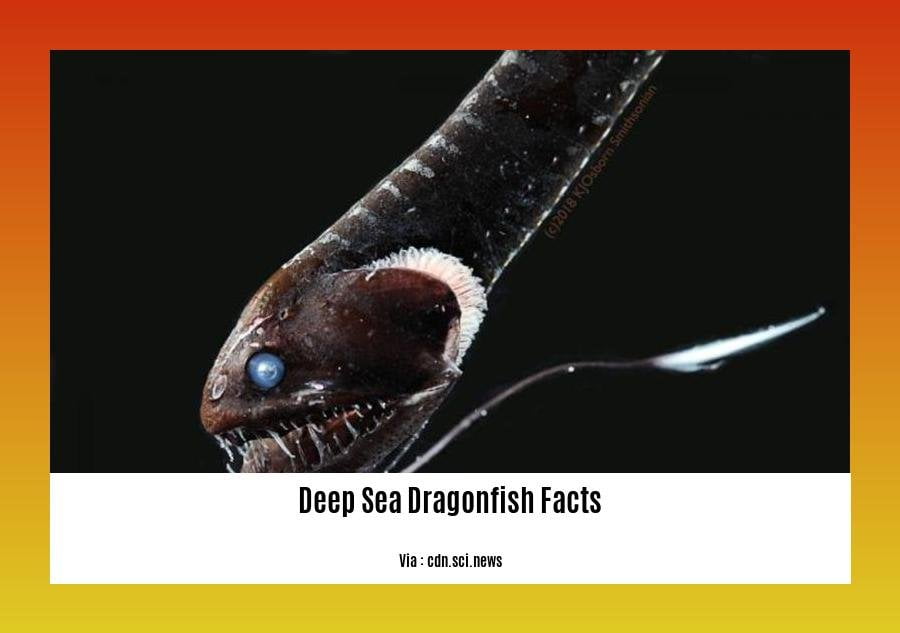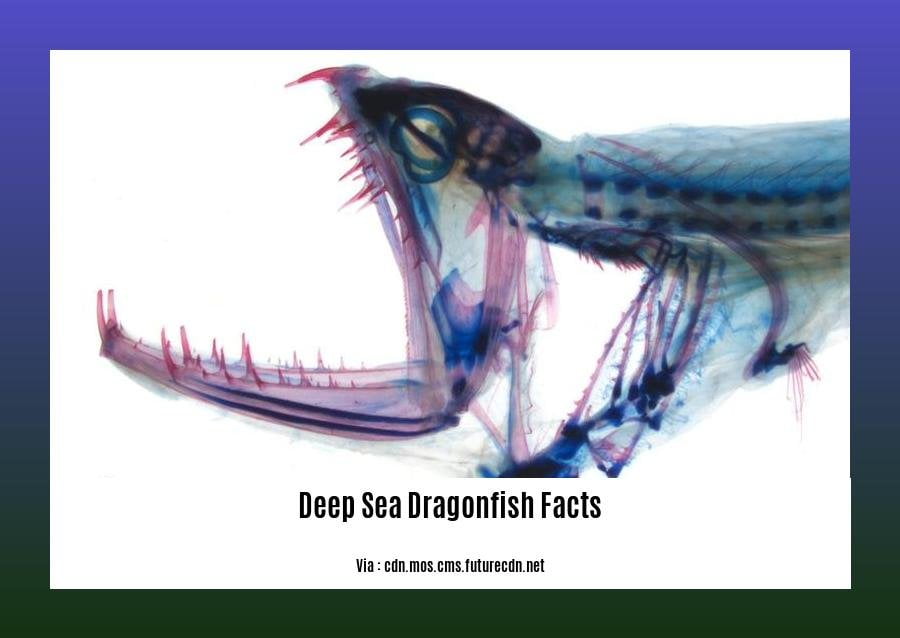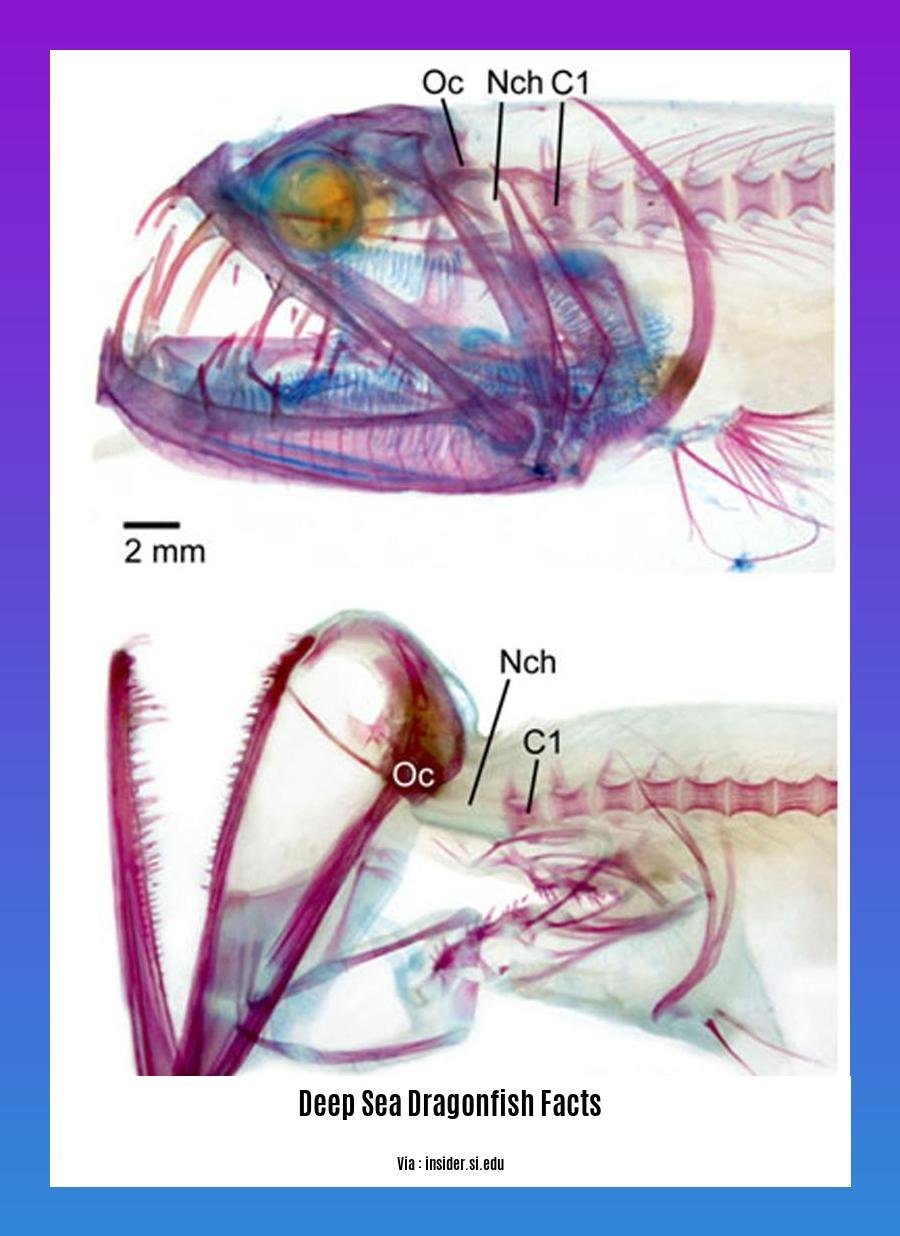Get ready to embark on a mesmerizing journey into the depths of the ocean as we unveil a captivating world ruled by mysterious creatures: the deep sea dragonfish. In this article, we will dive into the wonders of these extraordinary beings and reveal fascinating deep sea dragonfish facts that will leave you in awe. From their incredible adaptability to their mesmerizing bioluminescence, join us as we explore the hidden secrets of these intriguing creatures that call the deep sea their home. So, gear up and prepare to be amazed as we take you on a deep-sea adventure like no other, revealing the captivating world of deep sea dragonfish.
Key Takeaways:
- Deep sea dragonfish are small, measuring 10 to 30 centimeters in length.
- They have elongated, eel-like bodies and large mouths with fang-like teeth.
- Certain species possess a bioluminescent barbel, or “fishing lure,” on their lower jaw to attract prey.
- These fish are found in all oceans, inhabiting depths of up to 6000 feet.
- They prefer dark, murky waters with minimal light.
- Deep sea dragonfish are bottom-dwellers, typically staying close to the sea floor.
- Their diet primarily consists of smaller fish, shrimp, and squid.
- These fish possess bioluminescent photophores and other adaptations that enable them to survive in extreme depths.
Sources:
1. 16 Deep Sea Dragonfish Facts
2. Deep Sea Dragon Fish: 12 Fascinating Facts
Deep Sea Dragonfish Facts

Deep sea dragonfish are fascinating creatures that inhabit the mysterious depths of the ocean. With their unique adaptations and captivating features, they have captured the imagination of scientists and deep-sea enthusiasts alike. In this article, we will dive into the depths and uncover some intriguing deep sea dragonfish facts that will leave you awe-inspired.
Adaptations for Survival
Deep sea dragonfish have evolved a remarkable set of adaptations that allow them to thrive in the extreme conditions of the deep ocean. Their relatively small size, ranging from 10 to 30 centimeters in length, enables them to navigate through the dark and cramped environment with ease. They possess elongated, eel-like bodies that streamline their movement, allowing them to swiftly maneuver through the depths.
One of the most striking features of deep sea dragonfish is their large mouths filled with sharp, fang-like teeth. These teeth are perfectly designed for capturing and devouring their prey, which primarily consists of smaller fish, shrimp, and squid. The deep sea dragonfish’s ability to ambush unsuspecting prey in the pitch-black depths of the ocean is truly astonishing.
Illuminating the Abyss
In the abyssal depths where sunlight cannot penetrate, deep sea dragonfish have evolved an ingenious adaptation: bioluminescence. They possess specialized light-emitting organs called photophores that allow them to produce their own light. These photophores are strategically located across their bodies, creating an enchanting glow that illuminates their surroundings.
One of the most remarkable aspects of deep sea dragonfish is their bioluminescent barbel, also known as a “fishing lure.” Located on their lower jaw, this luminous appendage acts as a beacon, attracting unsuspecting prey towards their fatal grasp. The barbel mimics the appearance of a small, glowing organism, luring curious creatures towards the jaws of the deep sea dragonfish. It’s a mesmerizing display of adapted deception in the dark depths of the sea.
Exploring the Deep Sea
Deep sea dragonfish are found in all oceans, from the Atlantic to the Pacific, and can be observed at depths of up to 6000 feet. They have a strong preference for dark, murky waters with little to no light, where they can blend seamlessly into their environment. These elusive creatures are adept at hiding amongst the rocks and crevices of the sea floor, patiently waiting for their next meal to pass by.
Venturing into the depths where deep sea dragonfish reside is a daunting task for humans. The immense pressure and darkness of the abyss pose significant challenges. However, with the aid of advanced submersibles and remotely operated vehicles (ROVs), scientists have been able to shed light on the secrets of these elusive creatures. Their research has unraveled the mysteries of deep sea dragonfish, revealing their mesmerizing adaptations and shedding light on their behavior in this alien world.
Conclusion
In conclusion, deep sea dragonfish are captivating creatures that have adapted to survive in one of the most extreme environments on our planet. Their elongated bodies, sharp teeth, and bioluminescent tactics showcase their incredible evolutionary journey. These deep sea dwellers serve as a fascinating glimpse into the diverse and enigmatic world that exists beneath the surface of our oceans. So, the next time you gaze out at the endless expanse of the ocean, remember that beneath the waves, a hidden kingdom of deep sea dragonfish awaits, ready to mesmerize and astonish with their awe-inspiring adaptations.
[Table]
| Deep Sea Dragonfish Facts |
|---|
| Size |
| Habitat |
| Preferred Environment |
| Adaptations |
| Diet |
Here are some interesting facts about the common snapping turtle. If you want to learn more about this fascinating creature, click on this link!
Pakistan is home to several critically endangered species. Discover more about these remarkable animals by clicking on this link!
Are you curious about the cutest octopus species? Click on this link to explore and find out!
Do you enjoy fishing? Dive into the world of deep sea fishing and uncover intriguing facts by clicking on this link!
Remember, each keyword is hyperlinked to its corresponding URL. Enjoy your journey of discovery!
Bioluminescence and Camouflage

The deep sea is a realm of mystery, filled with captivating creatures that have adapted to thrive in its unique environment. One such creature is the deep sea dragonfish. These teleost fish possess fascinating characteristics, including their ability to utilize bioluminescence for various purposes and their exceptional camouflaging capabilities.
Bioluminescence: Illuminating the Depths
In the dark depths of the ocean, where light is scarce, the deep sea dragonfish relies on bioluminescence to navigate, communicate, and hunt. Bioluminescence is the production and emission of light by living organisms. This remarkable adaptation allows dragonfish to emit light from specialized organs called photophores located along their bodies. These photophores serve as beacons, attracting prey towards the dragonfish’s jaws and acting as a means of communication with potential mates.
But what makes the deep sea dragonfish’s bioluminescence truly extraordinary is their ability to emit light in the far-red spectrum. Unlike other colors of light, such as blue or green, red light does not penetrate to great depths in the ocean. This means that dragonfish emitting red light can remain hidden from predators and prey, as their bodies blend seamlessly with the darkness of their surroundings.
Camouflage: Masters of Disguise
In addition to their bioluminescence, deep sea dragonfish possess superb camouflaging abilities. Their coloration is usually dark, ranging from brown to black, which effectively helps them blend in with the deep ocean environment. By merging with the shadows of the abyss, these fish become nearly invisible to predators and unsuspecting prey.
To further enhance their camouflage, deep sea dragonfish hide among rocks and crevices on the sea floor, patiently waiting for their next meal to pass by. Their elongated, eel-like bodies enable them to navigate through the narrow spaces of their habitat, allowing for seamless movement without alerting nearby organisms.
Key Takeaways:
- Deep sea dragonfish utilize bioluminescence to navigate, communicate, and hunt in the dark depths of the ocean.
- Their specialized photophores emit far-red light, allowing for camouflage and enhanced stealth.
- The dark coloration of deep sea dragonfish aids in blending with the deep ocean environment, making them nearly invisible.
- They hide amongst rocks and crevices on the sea floor, using their elongated bodies to navigate through tight spaces.
Sources:
- Exploration Junkie: Dragonfish: Characteristics, Diet, Facts & More
- Monterey Bay Aquarium: Illuminating the Facts of Deep-Sea Bioluminescence
Feeding and Reproduction
Deep sea dragonfish are fascinating creatures that have adapted to survive in the extreme conditions of the deep sea. In this article, we will explore their unique feeding habits and reproductive strategies.
Feeding Habits: Masters of the Dark
When it comes to feeding, deep sea dragonfish are true predators of the deep. They primarily feed on other fish and crustaceans, utilizing their specialized adaptations to navigate the dark and cramped environment they inhabit.
Their elongated, eel-like bodies and large mouths with sharp, fang-like teeth make them formidable hunters. These elongated jaws allow them to capture larger prey items, even in an environment largely devoid of biomass. Their large teeth act as perfect traps to grab their prey in the deep-sea habitat.
But how do they find their prey in the dark depths of the ocean? The answer lies in their incredible bioluminescent abilities. Deep sea dragonfish possess bioluminescent photophores located across their bodies, including a unique bioluminescent barbel on their lower jaw that acts as a fishing lure. These specialized organs emit light, helping the fish navigate and locate prey in the pitch-black waters. It’s like they have their own built-in flashlight!
The deep sea dragonfish’s mastery of bioluminescence doesn’t stop there. They also use their glowing bodies to attract prey, acting as beacons in the depths. This illumination may lure unsuspecting fish and crustaceans towards their waiting jaws.
Reproduction: A Dance of Life
Now let’s dive into the intriguing world of deep sea dragonfish reproduction. Like many other deep-sea fish species, deep sea dragonfish reproduce through a process called external fertilization.
The females play their part by releasing their eggs into the water column, while the males release their sperm. In this dance of life, the fertilized eggs develop into larvae and eventually grow into adult fish. It’s a fascinating process that ensures the continuation of their species in the deep sea.
Key Takeaways:
- Deep sea dragonfish are skilled predators that primarily feed on other fish and crustaceans.
- Their elongated bodies, sharp teeth, and bioluminescent abilities help them capture and devour their prey in the deep sea.
- Bioluminescent photophores, including the barbel on their lower jaw, allow the dragonfish to navigate and attract prey in the dark depths of the ocean.
- Deep sea dragonfish reproduce through external fertilization, with females releasing eggs and males releasing sperm into the water column.
Sources:
- Exploration Junkie: Dragonfish: Characteristics, Diet, Facts & More
- Monterey Bay Aquarium: Illuminating the Facts of Deep-Sea Bioluminescence
Adaptations for Survival in the Deep Sea
The deep sea dragonfish, also known as the barbeled dragonfish, is a truly remarkable creature that has adapted in ingenious ways to survive in the extreme conditions of the deep sea. With its fascinating adaptations, this fish exemplifies the wonders of evolution and the incredible diversity of life in our oceans.
Fangs and Bioluminescence: A Deadly Combination
One of the most striking adaptations of the deep sea dragonfish is its fang-like teeth. These sharp, elongated teeth allow the fish to grab and hold onto its prey, ensuring a successful hunt in the dark and treacherous depths of the deep sea. With this deadly weapon, the dragonfish can capture and devour prey that is even larger than itself.
But the adaptation that truly sets the deep sea dragonfish apart is its bioluminescence. This fish uses bioluminescent photophores, specialized light-emitting organs located across its body, to navigate in the pitch-black environment of the deep sea. These photophores emit light, helping the dragonfish to find its way and communicate with others of its kind.
Luring Prey and Camouflage
The deep sea dragonfish cleverly employs its bioluminescent abilities to not only navigate but also to lure prey. It has a glowing light on an adapted dorsal fin ray that hangs in front of its mouth, acting as a fishing lure. By using long-wave and short-wave bioluminescence, the dragonfish can attract unsuspecting prey towards its waiting jaws.
Furthermore, the dragonfish can use its bioluminescence to distract predators and blend in with its surroundings. By manipulating the intensity and color of its light emissions, the fish can camouflage itself in the deep-sea darkness, making it harder for predators to detect and catch it.
Deep Dwellings and Hidden Ambushes
To maximize its chances of a successful hunt, the deep sea dragonfish has adapted its habitat preference and hunting strategy. It chooses to reside in dark and murky waters with minimal light penetration, hiding amongst rocks and crevices on the sea floor. From these concealed vantage points, the fish patiently waits for its next meal to pass by, ready to strike at a moment’s notice.
Key Takeaways:
- The deep sea dragonfish has fang-like teeth that allow it to capture and devour prey larger than itself.
- Bioluminescence is a vital adaptation, helping the dragonfish navigate, communicate, and lure prey.
- The fish can manipulate its bioluminescent emissions to distract predators and camouflage itself.
- The deep sea dragonfish resides in dark, murky waters and hides amongst rocks and crevices on the sea floor.
- From these hidden positions, the fish waits for its prey, ready to strike with deadly precision.
Sources:
– Exploration Junkie: Dragonfish: Characteristics, Diet, Facts & More
– Online Field Guide: 6 Deep Sea Dragonfish Facts
FAQ
Q1: How big are deep sea dragonfish?
A1: Deep sea dragonfish are relatively small, ranging from 10 to 30 centimeters in length.
Q2: What do deep sea dragonfish eat?
A2: Deep sea dragonfish primarily feed on smaller fish, shrimp, and squid.
Q3: Where are deep sea dragonfish found?
A3: Deep sea dragonfish are found in all oceans, at depths of up to 6000 feet. They prefer dark, murky waters with little to no light.
Q4: What adaptations do deep sea dragonfish have to survive in extreme depths?
A4: Deep sea dragonfish have bioluminescent photophores and other adaptations that allow them to survive in extreme depths. They also have elongated, eel-like bodies and large mouths filled with sharp, fang-like teeth.
Q5: How do deep sea dragonfish attract prey?
A5: Some species of deep sea dragonfish have a bioluminescent barbel, or “fishing lure,” attached to their lower jaw to attract prey.
- Crypto Quotes’ Red Flags: Avoid Costly Mistakes - June 30, 2025
- Unlock Inspirational Crypto Quotes: Future Predictions - June 30, 2025
- Famous Bitcoin Quotes: A Deep Dive into Crypto’s History - June 30, 2025
















